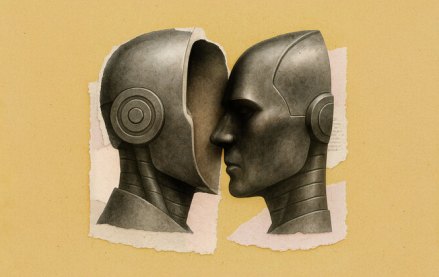Save 50% on a 3-month Digiday+ membership. Ends Dec 5.
Esquire’s Michael Sebastian on the workday of a magazine editor in the age of TikTok and AI

In the midtown Manhattan offices of Hearst Tower, surrounded by the familiar chaos of print production — stacks of back issues, proof pages scattered across the desk, the constant hum of editorial collaboration — Michael Sebastian presides over one of America’s most iconic magazines. With a twist.
At 44, the editor in chief of Esquire represents something of a paradox: a digital native who came up through the ranks of online journalism, now stewarding a 92-year-old print publication (and its various digital products) that recently notched the industry’s loftiest honors.
This spring, Esquire picked up both the Pulitzer Prize for Feature Writing — awarded to journalist Mark Warren for his article, “Death of a Small-Town Pastor,” about a small-town minister and mayor who died by suicide after his secret online life was exposed — and the National Magazine Award for General Excellence. For Sebastian, the awards are the validation of a philosophy that bridges old and new media — that great storytelling transcends format, and that heritage brands can thrive in the digital age without abandoning their print DNA.
Sebastian joined Esquire eight years ago as digital director, after running digital news operations for the magazine’s parent Hearst Magazines, contributing content to the websites of 18 titles that also include Harper’s Bazaar, Cosmopolitan and Town & Country.
Yet taking charge of Esquire was a singular challenge: modernizing a media institution without losing what made it iconic. The formula for that, he’s learned, lies not in choosing between print and digital but in making them work together, inextricably linked parts of a brand ecosystem.
WorkLife sat down with Sebastian to talk about what the typical workday of a magazine editor looks like now, the intersection of legacy media and digital innovation (including, naturally, the onslaught of AI), and what it takes to keep a heritage brand culturally relevant in an age of infinite content.
You come from a digital background and now you’re also running a print magazine. How has that perspective shaped your approach to Esquire?
I like to say that our digital manifestation — and I don’t just mean the website anymore; obviously, it’s all of these channels — is the beating heart of the brand, but the print magazine is the soul of the brand. It’s also the flagship store on Fifth Avenue. We need that because it differentiates us from an Instagram account or a website. Our audience likes it, the subscriber numbers remain strong, writers love to be in print, photographers love to see their stuff in print, and celebrities like to see themselves in print.
How do these platforms work together strategically?
All of these things fuel each other. When we book a celebrity for a cover, the thought is always: How is this going to perform in the digital environment? Five years ago, it was about website traffic. That remains important, but it’s also about engagement on Instagram, what kind of video we can produce that’s going to live on TikTok and YouTube. Print now serves digital very much, but if you don’t treat print like a bespoke product, readers and advertisers will recognize that.
What does the typical workday look like for a magazine editor now versus the past?
There are far fewer martinis in the afternoon! But seriously, no two days are the same. I oversee the brand — setting strategy, making sure we’re executing on everything from a big feature story to what we’re publishing on Instagram. I could be having lunch with an advertiser, meeting with the team about stories, but I also like to dip into the weeds. Yesterday I spent time reviewing digital headlines for all the celebrity profiles in our “Mavericks of Hollywood” package [the subject of Esquire’s September cover, featuring Leonardo DiCaprio], tweaking those with an editor. Maybe that’s below my pay grade, but I think it’s important.
Describe your own day.
During the school year, I have the early shift with my kids — I have a 10-year-old and a 6-year-old — so I’m making breakfast, getting them dressed, getting them to the bus. Then I’m in the office between 9 and 10, staying until 7 or 8. There’s still a lot of travel — [Esquire creative director] Nick [Sullivan] and I go to Florence, Milan and Paris for the [fashion] shows in June and January, so I’m gone most of those months.
How is AI changing magazine publishing?
We have access to enterprise ChatGPT and internal editorial guidelines, but we’re not using AI to create content. There’s a quote I love: “I don’t want AI to write and make art for me. I want AI to do my dishes and my laundry so I can have more time to make literature and art.” That’s exactly how we’ve approached this. How can we use tools to free up writers, editors, photographers, designers so they can do what they’re most skilled at and passionate about?
I use it for research when preparing for interviews, or to surface things from our digital archive. But AI can’t report a story. It can’t go to the Bowery Hotel bar and paint a scene. It can’t replace taste or experience. When Mark Warren writes about people who have lost someone they love, AI hasn’t had its heart broken or been in love.
How has the pace of change in general affected magazine work?
The pace of change that once lasted decades, then years, now seems to happen daily or weekly. You have to be up to that challenge to work here — and you have to love it like an ER doctor loves it, because you’re going to be thrown curve balls every day. If you just want to do what happened 30 years ago, it’s not going to work. But if you have that passion in your belly, it’s a great job.
Why are you confident about the future of magazines?
Esquire is a Tiffany brand. It’s been around for 92 years, survived the Great Depression, World War II, the upheaval of the ’60s, the great recession, the pandemic. There’s a lot of grit in our blood. The most venerable brands — Esquire, Vogue, GQ, Cosmo — they’re all still here and vibrant. They figured out how to do it. And the culture has changed where now young brands are trying to seem old, creating typefaces to make it seem like they’ve been around for 92 years. It’s really good to be a heritage brand right now.
More in Media

How AI’s hit to publisher traffic is quietly rewiring media M&A
Publishers’ AI-driven traffic declines are cooling M&A, stalling deals and lowering valuations. Some analysts are optimistic about 2026.

Digiday+ Research: Where publisher revenue stands with ads, video, content licensing and subscriptions
Digiday+ Research conducted a survey among nearly 40 publisher professionals in Q3. Here is what they had to say about their different revenue sources.

AI-powered professional learning: Inside the launch of Deloitte’s Scout
Deloitte last month launched Scout as part of its Project 120, the company’s $1.4 billion investment in professional development.








